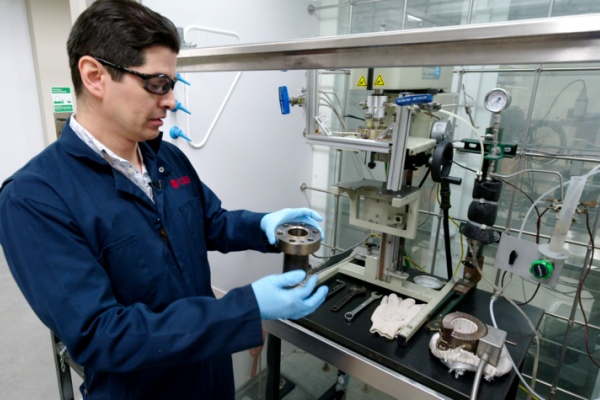UK researchers lead multidisciplinary project for next-generation organic semiconductors

A multi-institutional collaboration — led by University of Kentucky researchers Chad Risko and John Anthony — was one of 37 teams to receive National Science Foundation funding as part of that organization’s Designing Materials to Revolutionize and Engineer our Future (DMREF) program.
DMREF is a $72.5 million investment from NSF to drive the design, discovery and development of advanced materials needed to address major societal challenges. The DMREF program brings together a wide range of disciplines — including materials research, engineering, mathematics, computer science, chemistry and physics — to achieve outcomes not possible in isolation. DMREF projects also include industrial partnerships to facilitate technology translation and train the future U.S. workforce in materials development and deployment.
Risko and Anthony, professors in the Department of Chemistry in the College of Arts and Sciences and researchers at UK’s Center for Applied Energy Research (CAER), received funding for their project, “Accelerating the Commercial Readiness of Organic Semiconductor Systems (ACROSS).”
The four-year, $1.8 million award is engaging research collaborators at Wake Forest University and Princeton University and will coordinate with researchers at the National Institutes of Standards and Technology (NIST).
Carbon-based (organic) semiconductors provide distinct properties that can enhance and lead to new technologies in our increasingly technology-driven world — from electronic displays and lighting to large-area power generation and storage to medical and national security applications.
“These materials are complex,” said Risko, the John C. Hubbard Professor of Chemistry and principal investigator for ACROSS. “Many questions remain as to which organic semiconductors best fit each of these applications and how best to make them. To tackle these challenges and accelerate the commercial readiness of organic semiconductors, the ACROSS team brings together expertise from chemistry, physics, device engineering, materials science and modeling, and data science to speed up applications-specific materials design.”
The grant will also provide the ACROSS team the opportunity to train and challenge the next generation of organic electronic scientists who will lead the field into the future.
“The continued development of these new materials will require a transdisciplinary team of scientists and engineers, working together in a collaborative environment,” said Anthony, the C.W. Hammond Professor of Chemistry. “It will require talent — lots of talents from across multiple scientific disciplines. That’s an exciting component of this project. ACROSS provides a distinct, multidisciplinary environment to train the next generation of diverse and inquisitive scientists and engineers, where computers and machines will be vital to drive discovery.”
The 2023 class of DMREF awards involves 161 researchers at 61 universities across 30 states. Since 2012, DMREF has been NSF's primary response to the federal Materials Genome Initiative, whose mission is to discover, develop and deploy new materials twice as fast and at a fraction of the cost of traditional research methods.
Currently, the DMREF program joins four NSF directorates and 10 divisions — as well as seven federal research partners such as the Air Force Research Laboratory and NIST — to drive a culture shift that has led to a remarkable acceleration of materials research and development.
"By integrating numerous research disciplines across NSF as well as federal and industrial partnerships, this program truly revolutionizes the design, discovery and development of new materials for addressing urgent national needs," NSF Director Sethuraman Panchanathan said. "Some of these have been used to formulate highly sensitive therapeutic proteins to mitigate the primary effects of spinal cord trauma, carbon dioxide capture to address climate change, and advanced quantum materials and semiconductors for powerful computation and communication needs, to name just a few."
Research reported in this publication was supported by the National Science Foundation under Award Number 2323422. The opinions, findings, and conclusions or recommendations expressed are those of the author(s) and do not necessarily reflect the views of the National Science Foundation.
More from this series Research Priorities - Energy
Credits
David Melanson (Center for Applied Energy Research)


